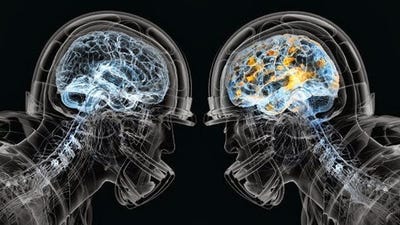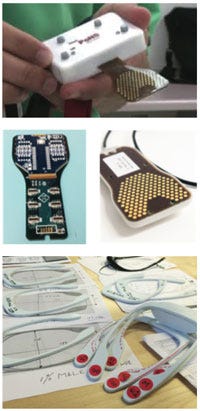Wearable for the Tongue Tackles Traumatic Brain Injury
January 22, 2015
|
This device, which is now in development by Helius Medical and Ximedica, helps people overcome mental deficits caused by traumatic brain injury. |
Here's a wearable unlike any you have ever heard of before: a device that connects to the tongue to stimulate the cranial nerves to help treat traumatic brain injury.
The device, which is in development by Helius Medical Technologies (Vancouver) and Ximedica (Providence, RI), was inspired by the work of Paul Bach-y-Rita, an American neuroscientists who was a pioneer in the field of brain plasticity.
In 1958, Bach-y-Rita's father had suffered a debilitating stroke. Convinced that, through exercise, the brain could recover from mental deficits, the neuroscientist set up testing his theories to help his father. "So he nursed his father back to health by having him do excruciating exercise for a long period of time," says Phil Deschamps, CEO of Helius Medical Technologies (Vancouver). Over time, the exercises succeeded in helping his father recover most of his function.
The technology from Helius works according to the same principle: exercise, or in this case exercise conjoined with neural stimulation, can work as a catalyst to cause the brain to reorganize itself to overcome deficits caused by disease or trauma.
To understand the technology, think of someone who has had a stroke. "Let's say that the part of the brain that dies [in the stroke patient] is the part that moves the right arm," Deschamps says. The neural impulses that are coming from the arm travelling up the spine no longer have a destination in the brain. Thus, the arm is incapacitated."
The device supplements the neural impulse--in this case, from the arm--with 27 million impulses that are delivered straight from the tongue directly to the learning centers of the brain. This essentially tricks the brain into thinking the arm is moving. The strength of the signal coaxes the brain into remodelling itself to try to find a new pathway for that movement, which ultimately helps it overcome mental deficits caused by trauma.
So why is the company using the tongue as a pathway? "This was the genius of Paul Bach-y-Rita, who helped develop this," Deschamps says. "99% of people think of the tongue as an apparatus for taste. But when you think about it from an evolutionary standpoint, the tongue from zero to six months is your primary learning mechanism." Everything a baby grabs and puts into their mouths, the tongue is used to determine whether it is hard, soft, desirable or undesirable. The tongue is tied to the learning centers of the brain--in particular to the pons--part of the brain stem.
|
A range of form factors were developed by Ximedica and tested in user studies. Shown here is an iteration that fared well in those studies. |
Scientists eventually had the idea to communicate to the learning centers of the brain via the tongue and to obtain patent protection for them. "Now, the company owns all of the patents that have to do with stimulating the tongue to combine with physical exercise to produce a therapeutic outcome," Deschamps says.
The bulk of the early research on this attempted to find an interface that would work with the tongue to pass current through it to produce the right kind of neural impulses. The main goal was to try and produce neural impulses that travel from the tongue to the brain that mimic motor impulses that come up through the spine. "A large part of the original research was trying to refine the stimulation pattern so we would be able to produce that through the tongue," Deschamps explains.
"With respect to the device design element, we had a good head start because the scientist who developed what I call the 'lab widget' produced the right waveform, frequency, and electrical stimulation to produce the desired outcome," Deschamps recounts. When Helius began to collaborate with Ximedica, the company was focused on taking the basic lab technology and evolving into a more sophisticated design that would ultimately pass regulatory muster.
"Our goal was to make it as true to the original stimulation pattern," he says. "The major design issues were around trying to make sure the form was improved to try to help patients use the device more simply and to reproduce the original waveform as much as humanly possible." This requires making the device not only simple to use, but also compatible with users' normal exercise routines and lifestyles.
"Quite frankly, it is a counterintuitive design," Deschamps says. "The original device was something that fit entirely in your mouth and all of the pulse generation were sitting right outside of the mouth." This made it somewhat difficult for the user to to do their exercises without clamping down on it to hold it in their mouth--owing to the weight of the early prototype." The designs that Ximedica came up with focused on using the neck and shoulders to support the weight of the device. The design makes use of a tongue array linked to a cable. "It is now much more self-contained and easier for patients to be able to hold in their mouth, allowing them to do the exercise more easily," Deschamps concludes.
Ximedica is exhibiting at MD&M West at booth #1676, which is held February 10-12, 2015 in Anaheim, CA. |
Brian Buntz is the editor-in-chief of MPMN and Qmed. Follow him on Twitter at @brian_buntz.
Related Content
4 Things Football's Concussion Problem Is Teaching Medtech

About the Author(s)
You May Also Like




